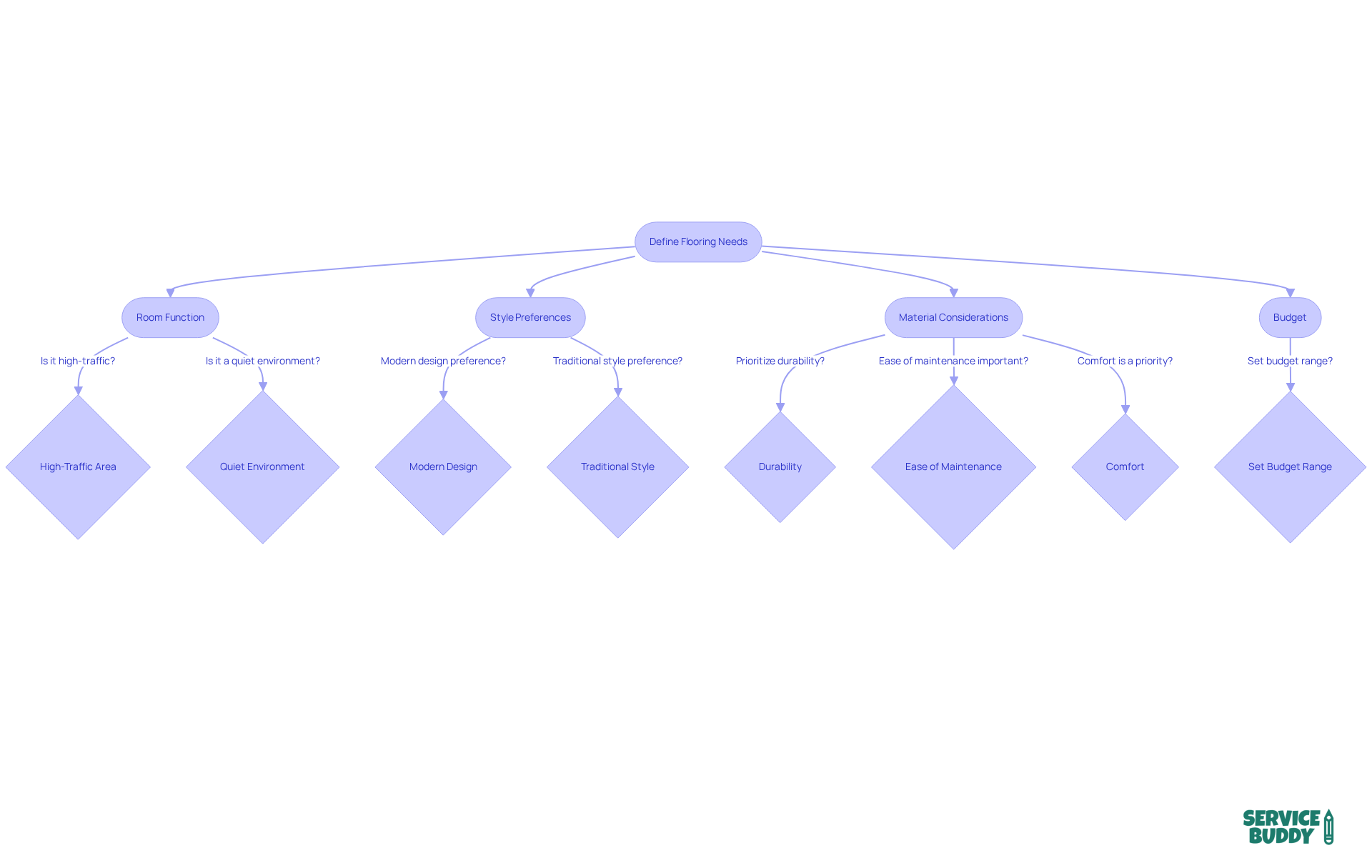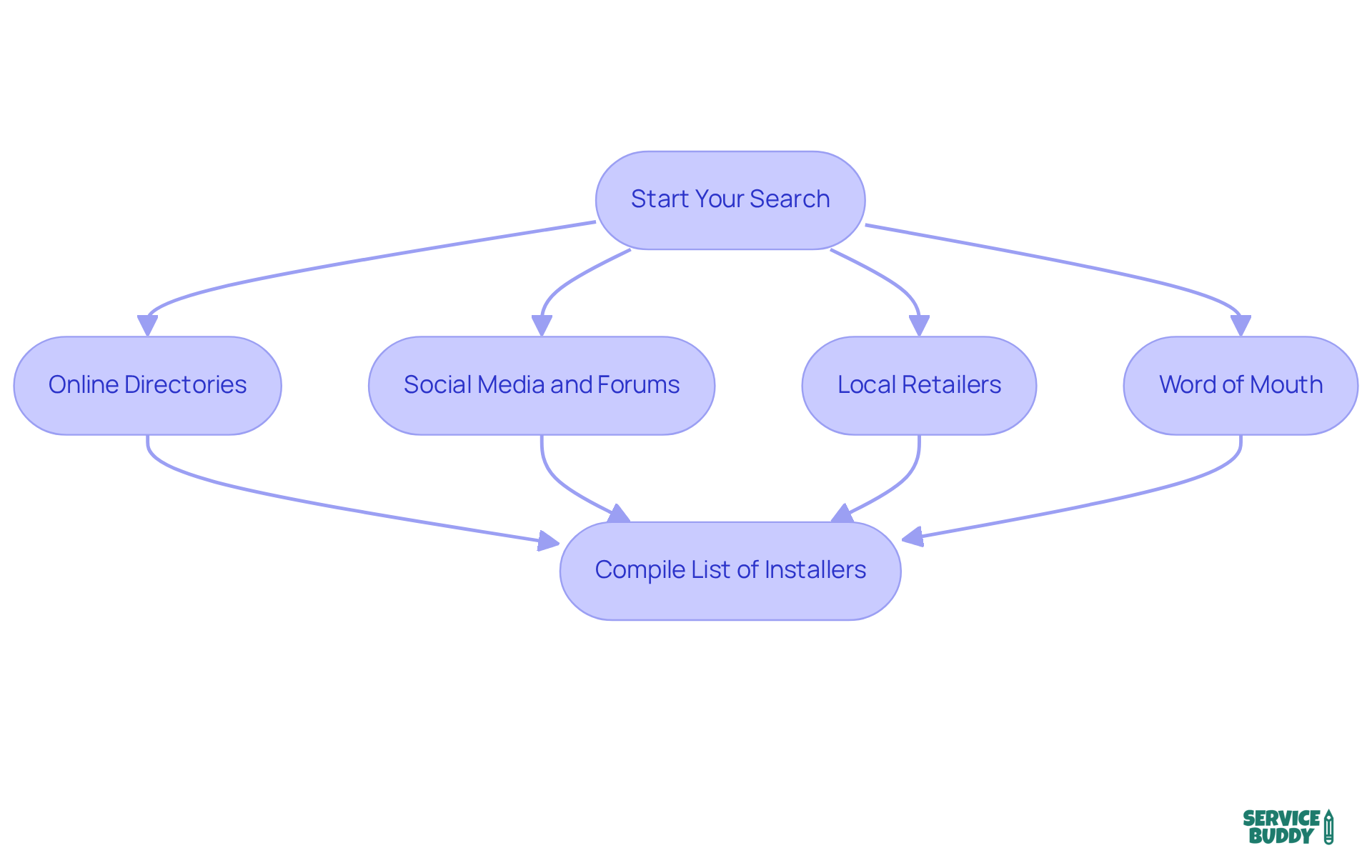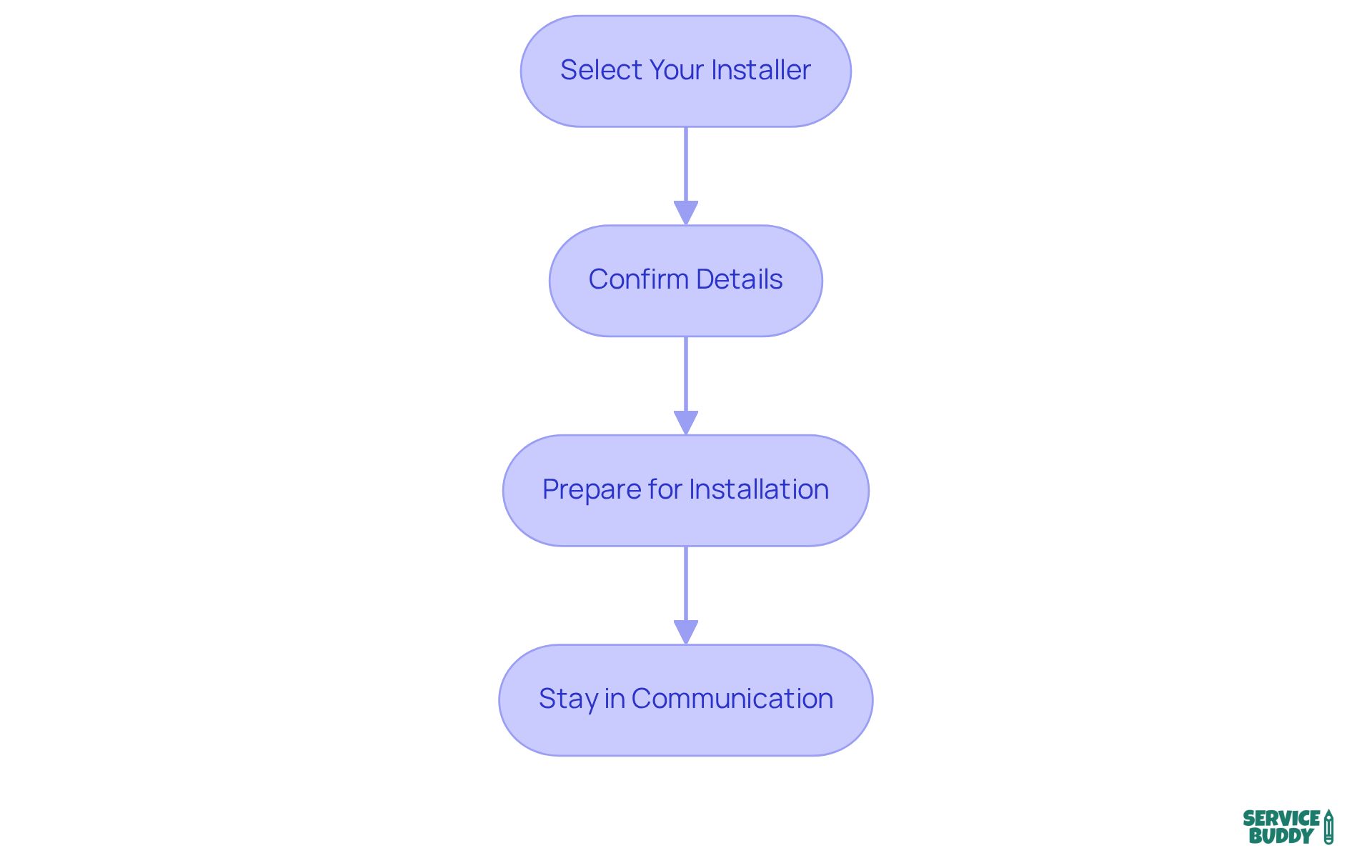Overview
This article outlines five essential steps for finding the right floor installer near you. It emphasizes the importance of:
- Defining your flooring needs
- Researching local installers
- Evaluating qualifications
- Requesting quotes
- Finalizing your choice
Each step is bolstered by practical advice, such as:
- Assessing room function and style preferences
- Utilizing online directories for thorough research
- Ensuring that installers are licensed and insured
Collectively, these strategies guide homeowners in making informed decisions, ultimately leading to a successful flooring installation.
Introduction
Finding the ideal flooring installer can indeed be a formidable challenge, particularly given the vast array of options and the substantial investment at stake. This guide presents a streamlined approach designed to assist homeowners in navigating the selection process with confidence. It ensures that their flooring project aligns not only with aesthetic aspirations but also with practical requirements. Yet, with countless choices and potential pitfalls, how can one guarantee that they are making the right decision for their home?
Define Your Flooring Needs and Preferences
Begin by evaluating your area to pinpoint the primary function of the surface. Consider these critical factors:
- Room Function: Determine whether the space is high-traffic, like a hallway, or a quieter environment such as a bedroom. Your flooring choices must reflect the room's demands; for instance, like tile or luxury vinyl plank are optimal for bustling areas, while softer materials like carpet or cork may be more fitting for serene settings.
- Style Preferences: Reflect on the aesthetic you aim to achieve. Are you inclined towards a modern design with sleek finishes, or do you favor a more traditional style? This decision will influence your material selection and overall design approach.
- Material Considerations: Assess what matters most to you—durability, ease of maintenance, or comfort. Luxury vinyl plank is gaining popularity for its affordability and resilience, making it ideal for families and active households. Additionally, options like cork and engineered wood are recognized for their durability and can enhance appeal to potential buyers.
- Budget: Set a budget range that encompasses both materials and installation costs. In 2025, the average expense for installing new surfaces in a standard 320-square-foot living area is approximately $3,162. This figure should account for potential extras and unforeseen expenses to ensure a thorough financial plan.
By thoughtfully addressing these considerations, you will gain a clearer insight into your surface needs, streamlining your search for a floor installer near me and ensuring that your project is successful and aligns with your style and practical requirements.

Research Local Flooring Installers
Begin your search for the right flooring installer by leveraging a variety of online platforms and local resources:
- Online Directories: Utilize websites such as Yelp, Angie's List, and Houzz, which offer comprehensive lists of local flooring installers along with customer reviews. These platforms can help you gauge the based on real user experiences. A significant percentage of consumers rely on online directories for contractor recommendations, making them a valuable resource.
- Social Media and Forums: Engage with platforms like Facebook and Reddit, where community members share personal recommendations and insights. These discussions provide valuable information about local contractors and their reputations. As noted by industry expert Stacey L. Nash, utilizing social media can enhance your search for reliable contractors.
- Local Retailers: Recommend visiting nearby stores to ask for a [floor installer near me](https://blog.servicebuddy.io/find-the-right-flooring-specialist-near-me-in-5-easy-steps). Many stores have established relationships with trusted contractors, making them a reliable source for referrals. Companies like Romero Hardwood Floors Inc have built a strong reputation through positive customer experiences, which local retailers can attest to.
- Word of Mouth: Don’t underestimate the power of personal referrals. Inquire with friends, family, or neighbors regarding their experiences with installation specialists, as their insights can direct you toward trustworthy professionals. Remember, hiring licensed and insured contractors for surfaces is crucial to avoid potential issues, as highlighted in various case studies.
After collecting this information, compile a list of potential installers to assess further, ensuring you select the best match for your project.

Evaluate Qualifications and Customer Reviews
- Licensing and Insurance: It is crucial to confirm that the installer possesses a valid license to operate in your area and carries liability insurance, including general liability and workers’ compensation. This step not only ensures compliance but also provides protection against potential accidents. Industry specialists emphasize that employing licensed and insured installers significantly reduces risks and guarantees adherence to safety protocols, ultimately enhancing professionalism within the sector.
- Experience: Seek installers with substantial expertise, ideally averaging four years or more in surface laying. Licensed contractors, particularly those who are floor installers near me, are required to have a minimum of four years of practical experience, which is vital for certain types of surfaces, as it indicates a deeper understanding of installation methods and challenges. Certified installers, who have undergone extensive training, are particularly valuable, contributing both expertise and credibility to the project.
- Customer Reviews: Conduct thorough investigations of reviews on platforms such as Google, Yelp, and Angie's List. Pay particular attention to feedback regarding punctuality, quality of work, and customer service. Additionally, request references and review portfolios to evaluate past projects and customer satisfaction levels of a floor installer near me. Positive testimonials can provide insights into the provider’s reliability and professionalism, while negative reviews may highlight potential concerns.
- Portfolio: Ask for examples of previous work to assess the installer’s style and quality. A well-curated portfolio showcases their diverse skills and successful projects, helping you determine whether their work aligns with your vision. Viewing actual samples along with can better shape your expectations.
Conducting this thorough assessment will enable you to identify the most suitable candidates for your project, such as a floor installer near me, ensuring a successful installation experience.

Request Quotes and Compare Services
Contact your shortlisted installers to request detailed quotes, ensuring you cover the following critical elements:
- Scope of Work: Confirm that the quote encompasses all job aspects, including material costs, labor, and any additional fees, such as the removal of old flooring, which can range from $0.70 to $5 per square foot. Additionally, clarify whether the flooring cost includes extra materials, as this is essential for managing client expectations.
- Breakdown of Costs: Request a detailed breakdown of costs to gain clarity on where your investment is allocated. This should include separate costs for moldings, underlayment, and any special tools or fixings required for the project. Be aware that subfloor repairs may be necessary if the subfloor is damaged or uneven, potentially adding to your budget.
- Timeline: Inquire about the estimated timeline for completion, including potential delays. Clear communication about timelines is essential, as unrealistic expectations can lead to client dissatisfaction. It is also advisable to be present during the installation process to ensure proper layout and address any issues that may arise.
- Warranties and Guarantees: Verify the on both materials and workmanship. Ensure that the quote clearly states what is covered, including any non-installation-related issues, to manage client expectations effectively.
After receiving multiple quotes, compare them side by side to identify the best value for your needs. It is also wise to set aside a contingency budget of around 10% for unexpected costs, as this can help mitigate financial surprises. This practice not only helps in making informed decisions but also fosters trust with clients by demonstrating transparency and thoroughness in your quoting process.

Finalize Your Choice and Schedule Installation
After comparing quotes and evaluating your options, it’s time to make your final decision:
- Select Your Installer: Choose the installer that best meets your needs based on qualifications, reviews, and quotes.
- Confirm Details: Contact the chosen installer to confirm the details of the project, including the start date, payment terms, and any preparations needed on your part. Ensuring both parties are aligned is essential to avoid misunderstandings.
- Prepare for Installation: Clear the area where the surface will be set up, remove furniture, and ensure the space is accessible for the installers. Statistics indicate that approximately 70% of homeowners , which can lead to delays. Adequate preparation not only enables a smoother setup but also assists in preserving the integrity of your new flooring. Consider removing baseboards and shoe moldings to simplify the process.
- Stay in Communication: Keep an open dialogue with your floor installer near me as the date approaches to address any last-minute questions or concerns. Effective communication techniques, such as regular check-ins and confirming timelines, can significantly improve the experience of setting up. As mentioned by industry specialists, clear communication is essential for a successful endeavor.
By diligently following these steps, you will set the stage for a successful flooring installation, ensuring that your project runs smoothly and meets your expectations.

Conclusion
Selecting the right floor installer is a critical step in ensuring a successful flooring project. Approaching this task with a clear strategy can significantly impact the outcome. By defining your flooring needs and preferences, researching local installers, evaluating their qualifications, requesting quotes, and preparing for installation, you can achieve a seamless and satisfying experience.
This guide has shared essential insights, highlighting the importance of understanding room function and style preferences. Leveraging online directories and personal referrals proves invaluable, as does assessing qualifications through licensing, experience, and customer feedback. Each step empowers homeowners to make informed decisions, ensuring the chosen installer aligns perfectly with their vision and requirements.
Investing time in this process not only enhances the likelihood of a successful installation but also contributes to long-term satisfaction with your new flooring. By diligently following these steps, homeowners can confidently embark on their flooring journey, transforming their spaces while ensuring quality workmanship and a smooth installation experience.
Frequently Asked Questions
How do I define my flooring needs and preferences?
Start by evaluating the primary function of the space, considering factors like room function (high-traffic vs. quiet environments), style preferences (modern vs. traditional), material considerations (durability, maintenance, comfort), and your budget for both materials and installation.
What factors should I consider regarding room function when choosing flooring?
Consider whether the room is high-traffic, like a hallway, or quieter, like a bedroom. Durable options like tile or luxury vinyl plank are best for busy areas, while softer materials like carpet or cork may be more suitable for serene settings.
What materials are recommended for different flooring needs?
For high-traffic areas, durable options like tile or luxury vinyl plank are optimal. For quieter spaces, softer materials such as carpet or cork are preferable. Luxury vinyl plank is popular for its affordability and resilience, while cork and engineered wood are also durable options.
How much should I budget for flooring installation?
In 2025, the average cost for installing new surfaces in a standard 320-square-foot living area is approximately $3,162. This budget should include materials, installation costs, and potential extras or unforeseen expenses.
How can I research local flooring installers?
Use online directories like Yelp, Angie's List, and Houzz for lists of local installers and customer reviews. Engage with social media platforms like Facebook and Reddit for personal recommendations. Visit local retailers for referrals and ask friends or family for their experiences with contractors.
Why is it important to hire licensed and insured contractors for flooring installation?
Hiring licensed and insured contractors is crucial to avoid potential issues during installation. This ensures that the work meets industry standards and provides protection for both you and the installer.




